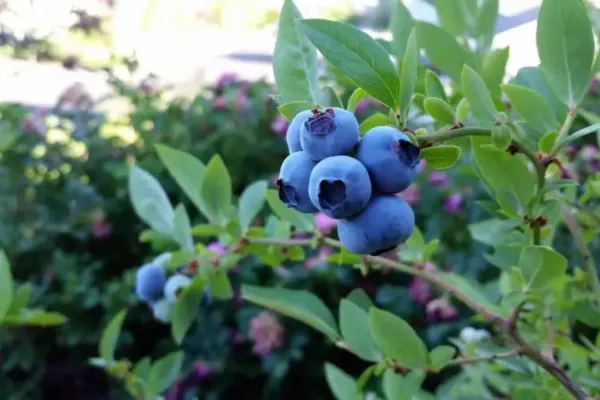
Your Backyard Fruit Bowl – Blueberries
Blueberries: a short family history
Suitable climates and growing conditions
Pests, diseases and what to do about them
Blueberries are a great example of a fruit that was relatively uncommon 30-odd years ago in New Zealand, but has become increasingly popular and commonplace over the last couple of decades – and for good reason, too. Not only are the fruit tasty, portable, have good keeping qualities and are easily processed, they are also a powerhouse of nutrients, fibre and anthocyanins (pigmented compounds with antioxidant and anti-inflammatory properties).
Literature from the early 1980s suggests to would-be growers that blueberries “…are not a fruit that is ideally suited for home gardens. Conditions for good growth are exacting and establishment of bushes is not easy.” Thankfully, advances in growing systems over the years, including the advent of many new, New Zealand-developed cultivars mean that a bountiful blueberry crop at home is well-within the reach of backyard and larger-scale growers alike.
Just as well, because blueberries are hardy, prolific producers rather well-suited to our climate. With careful attention to species and cultivar selection, blueberries will grow happily throughout the country and fruit over a reasonably long season. The fruit lends itself to a myriad of uses – and is just as, if not more popular eaten fresh out of hand as a snack, with cereal or in fruit salads as it is used for the more traditional blueberry muffins, pies and jams. Throwing the cat amongst the pigeons, I actually prefer blueberries cooked and appreciate the deeper flavours a little heat brings out. They blend remarkable well with savoury foods and the most out-there combination I’ve seen of late is a blueberry-scotch bonnet chilli sauce to go on pizza.
Whatever your persuasion, a few blueberry bushes in your garden will offer a hardy, low maintenance option and provide a little bit of extra variety over summer and autumn – and a no-brainer if you have little people about. Plants are widely available, easy to source and given a modicum of care and attention, should pay for themselves in a relatively short space of time. As an amenity plant, they make an interesting border plant for hedging (some species have brilliant autumn colour) and if properly cared for, can make long-lived, productive container plants given adequate space. This is particularly handy for those on small sections or renters/people on the move.
Blueberries: a short family history
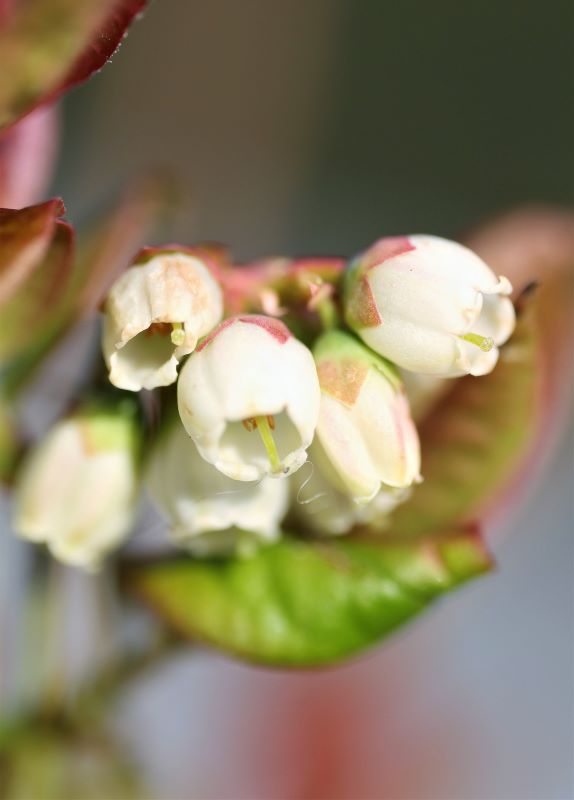
Blueberry flowers: Image by hannelorededecker from pixabay.com
Blueberries belong to the Ericaceae (heath or heather) family and are plants adapted to a set of fairly harsh growing conditions in their natural habitats. Native to North America, their close relatives include true cranberries, lingonberries and bilberries (which look similar to blueberries but have more sour, blue-black pulp as opposed to the whitish flesh of blueberries). In the ornamental line, they are related to rhododendrons, camellias and the moorland plant common across Scotland and northern England, heather. They arise from and are henceforth adapted to poor-quality, acidic soil types and fairly open and exposed scrubby shrub-dominated landscapes, and if we can mimic some of these conditions in the home garden, it is generally for the better.
Long utilised as an important food source for first nation peoples in both fresh and dried form, blueberries soon became a staple for early European settlers too. Commercial cultivation was slow to establish, but an increase in the fruit’s popularity in the latter half of the 20th century and the more recent rise of berries in general as a ‘superfood’ has seen a worldwide industry establish. Production is still centred in North America, with the USA and Canada producing the lion’s share of the global crop.
Much is made of blueberries’ antioxidant qualities, with the fruit containing high levels of anthocyanin compounds in its flesh, several important vitamins and hearty dose of fibre. Blueberries have also been found to possess a cohort of other health-giving qualities, including the ability to have positive effects on LDL cholesterol levels, reducing the effects of ageing, urinary tract health (similar to their cousins the cranberries), and activity against the pathogenic bacteria E. coli.
The main species include:
Highbush blueberry – Vaccinium corymbosum
This category is divided into southern (need 200-600 chilling hours – best for all areas north of Canterbury) and northern (600-1000 chilling hours – suitable New Zealand wide, but fruit best in areas with sufficient chilling hours) highbush varieties. They have high chilling requirements (require 800-1100 hours below 7°C each year), produce a crop within 2-4 years of planting, 45-75 days between fruit set and ripening. Upright growth habit, reaching two to four metres in height.
Rabbiteye blueberry – Vaccinium virgatum/V. ashei
Have a lower chilling requirement than highbush varieties (350-800 hours below 7°C each year). Fruit development is a bit slower, taking approximately 90 days from fruit set to harvest and is best left on the bush to ripen for approximately a week after the berries first change colour. Fruit generally ripens later than highbush varieties. Suitable to grow New Zealand wide, but later-fruiting varieties may struggle to ripen properly in cooler regions. Some varieties partially self-fertile, but always best planted with a friend or two nearby.
Lowbush blueberry – Vaccinium angustifolium
Uncommon in New Zealand, but a popular commercial species overseas due to its compact status. Generally require less than 500 chilling hours per year. Plants are generally less than a metre in height and can spread up to two metres horizontally. Lowbush cultivars are generally self-infertile and must be planted with a pollinising species to ensure a good crop. Berries ripen is 70-90 days from fruit set. Berries smaller than highbush and rabbiteye types.
Suitable climates and growing conditions
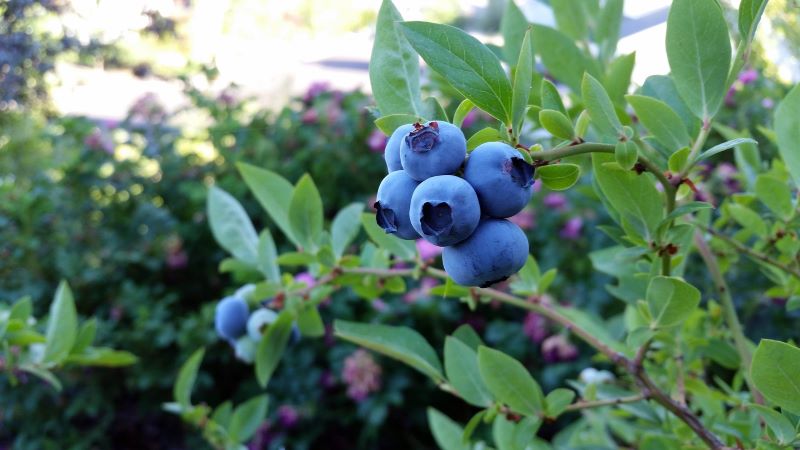
Blueberries on plant closeup: Image by Kari Dickinson from pixabay.com
Due to their hardy nature (cold tolerant down to around -30°C), blueberries can be grown successfully throughout New Zealand – just take a little care to match species with climate when it comes to the winter chilling hours typical of your region.
Being plants that thrive in relatively poor, acidic soils, it was fascinating to read that their native heathlands are actually a habitat significantly modified by human intervention. Blueberry growers overseas have a tradition of setting light to their fields every few years, mimicking what is often done in heathland ecosystems, subjecting the land to grazing or burning to prevent succession by other, undesirable shrubs and larger plant species and improve the soil’s fertility. In the Canadian Acadian French language, blueberry fields are known as brûlis, from brûlé, meaning burnt (yes, like crème brûleé!). This traditional management practice is fascinatingly still in use in modern times.
Depending on species, blueberry plants average one to three metres in height, but for practicality and ease of harvesting, are best kept to a maximum of two metres high in home garden settings. Allow half to one metre between plants if planting a hedge, and approximately two metres if planting specimen plants individually.
Blueberries are fairly slow-growing, so are ideally suited to pot culture in a large enough vessel. Make sure you use an acidic growing mix, e.g., something with a high peat content to keep the pH low. They have impressive longevity for a berry plant, if well-cared for, their lifespan can exceed 80 years, fruiting for at least 50 of these.
Pollination is by insects, predominantly bumblebees, which interestingly seem ideally adapted for blueberry flower morphology in terms of their wingbeat frequency stimulating pollen release. Highbush and rabbiteye blueberries are generally self-fertile, but definitely benefit from having at least another blueberry plant of the same species nearby.
Blueberries reach their full fruit production potential at three to four years of age, with good yields averaging 1 – 2.5 kg per plant and up to 5 kg/plant under optimal conditions. Successive selective picks must be made as not all the fruit in a flower cluster ripens at the same time.
Blueberries are propagated by semi-hardwood cuttings in spring-summer or hardwood cuttings taken in winter, stored in a chiller and then potted up to grow on in spring. They can be rather slow to root. Vigorous young stems can be layered in spring to autumn, but again, take a long time (approximately 18 months) to take root. If there’s a super-duper plant that you really want to propagate from, dividing off some suckers in early autumn or the following spring might be your best bet.
All things considered, blueberry plants are quite reasonably priced and it’s probably easiest to purchase named cultivars from a reputable nursery.
Site selection and planting
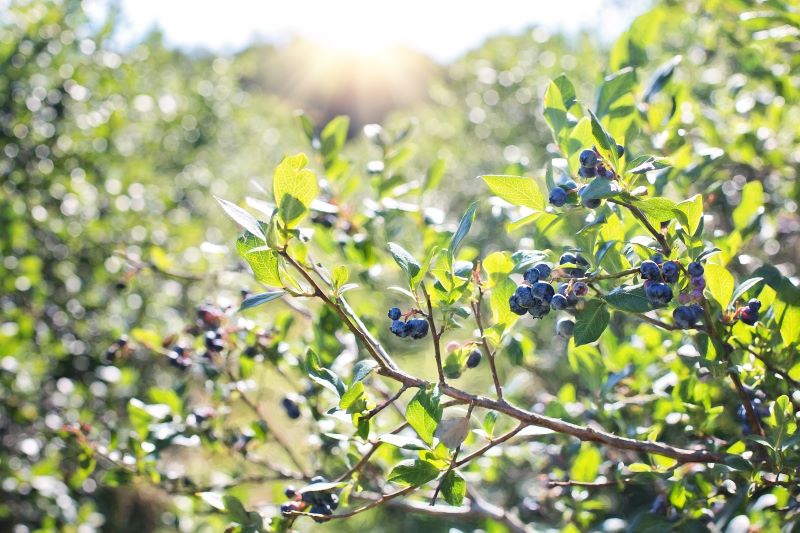
Blueberries on plant: Image by Jill Wellington from pixabay.com
Plant blueberries in winter when the bushes are dormant. Provide adequate shelter in the formative years and remove all flowers for the first year or two to send energy to the plant’s roots and ensure good plant growth in the establishment phase.
Choose a site in full sun unless you are in a particularly hot climate; in these conditions it’s advisable to provide some shade to avoid overly stressing the plants. Planting on a raised mound or bed can be beneficial on wetter soils to assist with drainage.
The most important factor to consider in blueberry culture is soil type. This must be acidic, within the preferred pH range of 4-5.2. They also appreciate soils with a decent organic matter content. You can adjust soil pH by adding peat moss, ammonium sulphate or a liquid sulphur-based specific soil acidifier. Blueberry plants will grow well in the company of conifers, particularly pine trees, and it is often suggested that pine needles make good mulch for blueberry plants for this reason.
If you’re new to growing fruit, this orchard overview covers the basics and how to get started.
Culture and care
Blueberries have a shallow, fibrous and quite compact root system, so take care when cultivating under plants to avoid disturbing them. A good layer of mulch helps retain water and nutrients while suppressing weeds at the same time. If your blueberry plant’s foliage starts to turn from blue-green to a purple-tinged hue, something may be amiss and you may need to adjust your watering regime, apply fertiliser or adjust the soil pH.
A regular supply of water is essential for berry formation and ripening and is particularly important when establishing young plants. Irrigation should preferably be applied close to the roots. Drip tape or trickle irrigation is ideal for this.
Blueberries aren’t gross feeders, and an occasional light fertilise is all that’s necessary in the early years. You can buy blueberry-specific fertiliser blends, or use any fertilisers labelled as suitable for other acid-loving plants such as camellias and rhododendrons. If using nitrogen fertilisers, provide as urea rather than nitrate.
Pruning
Blueberries fruit on the previous season’s (one year old) wood. Pruning should be carried out in winter when the plant is dormant, on a dry day. Focus on removing old wood that has fruited previously, which will stimulate the production of new growth. Thin out densely-branched areas. Remove dead, diseased or damaged wood and then weak, spindly growth. Aim to remove a few of the oldest branches from about year four or five onwards to keep the general age of branches below three to four years of age. This also encourages the development of young, vigorous new growth. Seal large cuts with pruning paint.
Pests, diseases and what to do about them
Blueberries are largely unaffected by any major pests or diseases…apart from the feathered, beaked variety. Make sure you net your crop well before the fruit begins to turn colour to avoid losing the lot. Planting in well-drained soils and locations will help avoid the dreaded Phytophthora root rot. Buying plants from a reputable nursery should ensure virus-free stock. Botrytis and Anthracnose can cause fungal rots in the fruit, particularly in wet seasons. Pruning to maintain airflow through the canopy and good orchard hygiene practices such as making sure you burn or otherwise dispose of prunings and diseased material all help maintain a low-disease pressure growing environment.
Varieties: My top picks
Remember to plant at least two plants of each type to ensure cross pollination and a good yield.

What to do with your crop
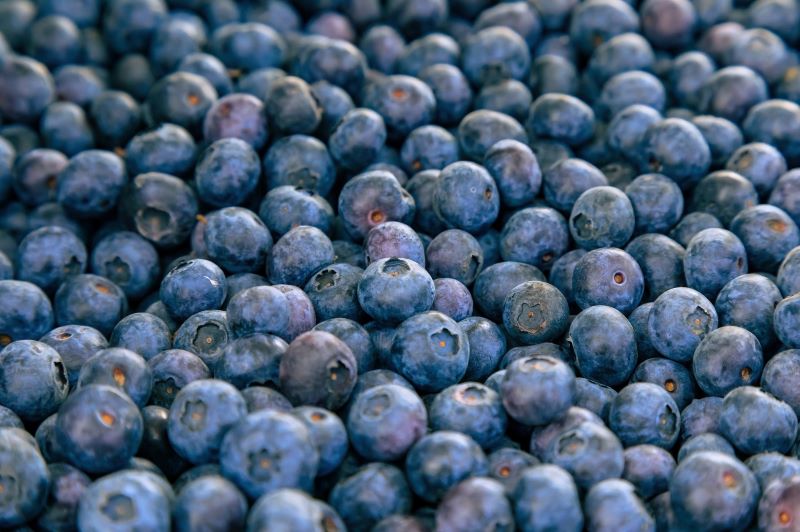
Blueberry fruit: Image by Jon Pauling from pixabay.com
After you’ve eaten your fill of fresh blueberries, start freezing. Blueberries are such neat and tidy units that free-flow freezing is basically automatic, no freezing on trays first required. Put plenty away so you have a ready supply for smoothies and winter baking.
They make an OK jam, it has a fairly subtle flavour and slightly grainy texture, but I personally prefer them in muffins or a pie. Digby Law’s seminal Pickle and Chutney Cookbook has a great recipe for a pleasantly acidic, slightly spiced blueberry sauce which works well served alongside all manner of savoury dishes, as well as served with plain yoghurt for an exotic twist.
Being a cooked blueberry fan, all manner of pies, muffins, cakes and crumbles are a possibility. They also make a cracking dessert sauce to serve alongside creamy masterpieces (see custard tart recipe below), especially when enhanced by a little citrus.
My early encounters with blueberry as a flavour were in commercial yoghurt (which I thought particularly exotic 30-odd years ago) and the very first blueberry muffins I ever ate, at a bed and breakfast run by family friends. Entranced by these mysterious objects, we obtained the recipe and a photocopy of the handwritten method remains tucked away in my collection to this day. I recently gave it a bit of a health(ier) update to reflect my current style of eating and am pretty pleased with the results.
Blueberry-banana muffins
Preheat oven to 200°C. Grease a 12-hole standard muffin tin or line with paper muffin cups.
1 ½ cups fine stoneground wholemeal flour (I use Milmore Downs)
½ cup soy flour (available from Bin Inn, adds protein and improves texture)
4 tsp baking powder
½ cup golden caster sugar
½ tsp salt
Drop the dry ingredients into a large mixing bowl and stir with a whisk to combine well. Add 1 cup of fresh or frozen blueberries and toss to coat the berries in flour – this helps prevent them bleeding through the muffins and resulting in a bright blue mess.
100 g butter
1 large egg
1 cup milk of your choice (can use ½ cup milk and ½ cup orange juice)
1 large ripe banana, mashed
Cinnamon-sugar mixture, to sprinkle (mix 2 tsp ground cinnamon with 2 tbsp golden caster sugar)
Melt the butter and cool slightly. Add to the dry ingredients with the egg, milk and mashed banana. Mix with a spatula or wooden spoon until just combined – you still want to see a few small pockets of dry flour, take care not to overmix.
Fill muffin cases 2/3 full with the batter (no matter how hard I try, I usually end up with ‘the curse of the 11 muffins’ where I never have enough mixture to fill the final case).
Sprinkle the tops with some cinnamon sugar and bake for 15-20 minutes until well risen and springy to the touch. Cool for 10 minutes before removing from the tin and cooling on a rack. These freeze exceptionally well and are great for school lunches, an al-desko work breakfast or mid-morning pick-me-up.
Custard tart with blueberry-limoncello sauce
I dreamed up this combination flatting in my 20s when I had a half-used container of preprepared custard in the fridge and a bunch of blueberries on the turn. The results were rather outstanding.
You’ll need a greased medium-size metal loaf tin for this. Preheat your oven to 180°C.
Pastry
115 g butter, slightly softened
45 g fine cornmeal (not cornflour!)
105 g plain flour
35 g custard powder
35 g icing sugar
Place all ingredients in a food processor and blend until ingredients form a soft dough. Add a few drops of cold water to bind if necessary.
Press into the base and about two inches up the sides of the greased loaf tin and set aside.
Custard filling
300 g ready-made vanilla custard
1 large egg
Whisk filling ingredients together until smooth and pour into base. Bake for approximately 30 minutes, until set but the tart still has a slight wobble and the pastry has browned. Cool to room temperature.
Blueberry-limoncello sauce
Stew 1-2 cups blueberries (fresh or frozen) with a dash of water in a saucepan until soft. Add two tablespoons of limoncello liqueur and thicken to the desired consistency with a little cornflour, tapioca starch or arrowroot mixed with a little cold water. Allow to cool slightly and serve warm with slices of the tart. Store leftovers in the fridge.
Disclaimer: The information supplied above is of a general nature and provided as reference material only. In regards to pest and disease control, please consult your agrichemical consultant for suitable products, application rates and further region-specific information.
Anna-Marie Barnes is an active member of the New Zealand Tree Crops Association who endeavours to grow and preserve as much of her own fresh produce as possible. When the weather’s no good for gardening, she can usually be found inside working on a batch of homemade cheese or soap.
The New Zealand Tree Crops Association is a voluntary organisation promoting interest in useful trees, such as those producing fruit, nuts, timber, fuel, wood, stock fodder, bee forage and other productive crops. Find out more about the NZTCA here: https://treecrops.org.nz/
Image Credits:
Blueberries on plant closeup: Image by Kari Dickinson from pixabay.com
Blueberries on plant: Image by Jill Wellington from pixabay.com
Blueberry flowers: Image by hannelorededecker from pixabay.com
Blueberry fruit: Image by Jon Pauling from pixabay.com

